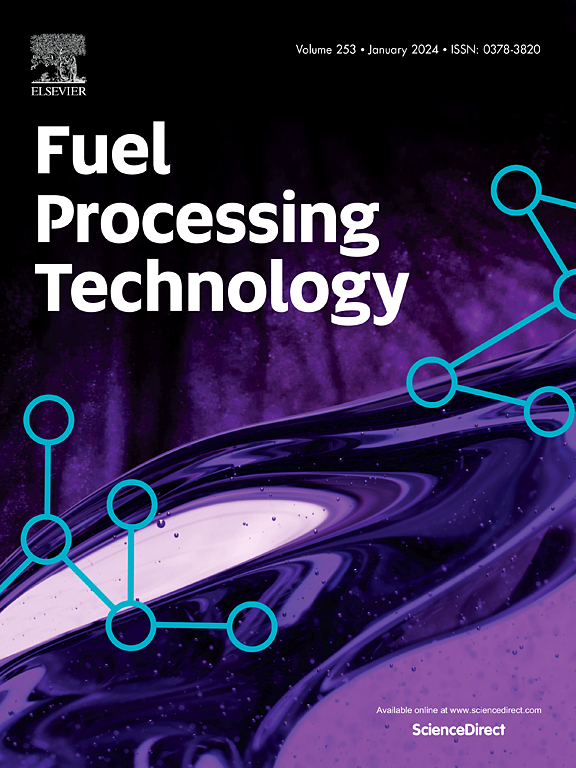轴压对新疆煤热解行为的影响:对富焦油煤原位热解的启示
IF 7.2
2区 工程技术
Q1 CHEMISTRY, APPLIED
引用次数: 0
摘要
富焦油煤原位热解(TCIP)是一项从地下富焦油煤层中提取焦油和天然气的绿色低碳技术。覆盖层压力是TCIP不同于常规地面热解的关键因素。通过模拟研究了轴向压力对新疆富焦油煤热解过程的影响。采用低场核磁共振和气相色谱法研究了其孔隙结构和挥发物的变化。结果表明:轴向应力作用下的热解过程中,孔隙结构与焦油气组成协同演化,呈现阶段性特征;10.0 ~ 17.5 MPa,煤被压缩至破裂,增强了热解过程中孔-裂隙连通性和对流换热。孔隙继续扩大,孔隙渗透率增加,促进挥发物释放,减少二次反应,导致焦油气产量增加,特别是轻质油和酚油,二氧化碳和C2+气体比例增加。相反,在20.0 ~ 25.0 MPa时,煤压实,孔隙-破裂连通性因裂缝闭合而恶化,对流换热减少,孔隙扩大现象减弱。基质传热的增强在煤基质内部形成了许多较小的热解孔,但连通性差降低了孔隙渗透率。这增加了挥发物的释放阻力,加强了二次反应,降低了焦油气的产率。而轻油、萘油、CH4、H2、CO的比例在增加。本文章由计算机程序翻译,如有差异,请以英文原文为准。
Axial pressure impact on pyrolysis behavior of Xinjiang coal: An inspiration for in-situ pyrolysis of tar-rich coal
Tar-rich coal in-situ pyrolysis (TCIP) is a green and low-carbon technology that extracts tar and gas from underground tar-rich coal seams. Overburden pressures are a crucial factor for TCIP that differs from conventional ground pyrolysis. This study investigated the impact of axial pressure on the pyrolysis of Xinjiang tar-rich coal using simulations. The variation of pore structure and volatiles was studied using low-field nuclear magnetic resonance and gas chromatography. Results indicated that pore structure and tar-gas composition evolved synergistically, and presented staged characteristics during pyrolysis under axial stress. 10.0–17.5 MPa, coals compressed to breakage, enhancing pore-fracture connectivity and convective heat transfer during pyrolysis. Pores continued to enlarge, porosity-permeability increased, promoting volatiles release and reducing secondary reactions, leading to increased tar-gas yield, particularly light and phenol oils, CO2, and C2+ gases proportion. Conversely, coals compacted at 20.0–25.0 MPa, pore-fracture connectivity worsened due to fracture closure, decreased convective heat transfer, and weakened pore enlargement phenomenon. The enhancement of matrix heat transfer formed many smaller pyrolysis pores within the coal matrix, but poor connectivity decreased porosity-permeability. This increased the release resistance of volatiles, strengthened secondary reactions, and reduced tar-gas yields. However, the proportion of light and naphthalene oils, CH4, H2, and CO is increasing.
求助全文
通过发布文献求助,成功后即可免费获取论文全文。
去求助
来源期刊

Fuel Processing Technology
工程技术-工程:化工
CiteScore
13.20
自引率
9.30%
发文量
398
审稿时长
26 days
期刊介绍:
Fuel Processing Technology (FPT) deals with the scientific and technological aspects of converting fossil and renewable resources to clean fuels, value-added chemicals, fuel-related advanced carbon materials and by-products. In addition to the traditional non-nuclear fossil fuels, biomass and wastes, papers on the integration of renewables such as solar and wind energy and energy storage into the fuel processing processes, as well as papers on the production and conversion of non-carbon-containing fuels such as hydrogen and ammonia, are also welcome. While chemical conversion is emphasized, papers on advanced physical conversion processes are also considered for publication in FPT. Papers on the fundamental aspects of fuel structure and properties will also be considered.
 求助内容:
求助内容: 应助结果提醒方式:
应助结果提醒方式:


